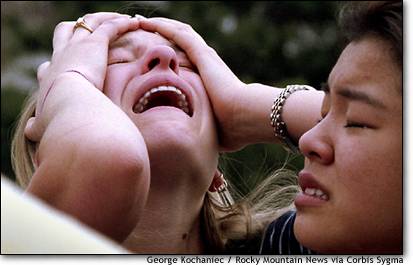
Violence
See also Firearm Deaths and Children

Columbine High School senior after witnessing her classmates getting killed April 20, 1999. Although shocking in its concentration, the 15 fatalities at Columbine were only slightly above the daily national average; 89 Americans are shot dead every day on average - that's almost 6 Columbine High School shootings a day. [See below.] Every day in the United States, 11.5 children die from firearms. [Source: National Rifle Association.]
Violence is a staggering public health problem in the United States. Although it has dropped recently, it remains several orders of magnitude higher than in other industrialized countries, and has risen significantly since World War II.
From 1960 to 1992, the rate of violence (assaults and homicide) has risen from 161 to 758 per 100,000 in the United States, a 371% increase. African Americans are particularly at risk; black males are 11 times more likely to be killed by gun shot wound than are whites. The United States has the #1 homicide rate of all industrialized countries:
|
|
General Population: |
Males, 15-24 (most violent age group): |
|
United States: |
34 |
40 ++++++++ |
|
United States, African Americans |
|
167 ++++++++++++++++++++++++++++++++++ |
|
Italy (next most violent industrialized country): |
4 |
6 + |
|
… |
|
|
|
Germany |
|
3 . |
|
Japan |
|
<1 - |
Source: Centers for Disease Control
17% of homicide occur within the family. Males and females tend to be equally prevalent as victims of family homicides.
In the United States, the homicide rate for infants (< 1 year-old) is 9.6/100,000:

Video of the shooters within Columbine High School, April 20, 1999. Easy access to semi-automatic weapons made what in any other industrialized country would have been a schoolyard fistfight into a massacre. Final body count: 15 dead, 20 wounded.
It is becoming extremely difficult to have a dispassionate discourse on the link between access to firearms and violence in the United States. The National Rifle Association is not entirely to blame, but they have forced some disturbing - from both a scientific and Civil Rights perspective - legislation through Congress. For example, it is illegal for the Centers for Disease Control to talk about, study, or even use the term "gun control" in any of its official publications. No member of the Centers for Disease Control is allowed to attend a conference financed by those advocating gun control. Consider this:
|
|
Firearm Death Rate Per 100,000, Ages 15-24**: |
|
|
United States: |
28 |
++++++++++++++++++++++++++++ |
|
Norway |
6 |
++++++ |
|
Israel |
5 |
+++++ |
|
Canada |
<5 |
++++ |
* source: International Collaborative Effort, as quoted in the American Academy of Pediatrics News, May, 2000.
**1993-1995
The Australian Experience
Another table, thanks to the NRA, was used by that organization to demonstrate that a mandatory gun confiscation program in Australia led to an increase in certain types of crime. The violent crime statistics shown below were retrieved on March 27, 2000, from the Australia Bureau of Statistics website:
|
VIOLENT CRIME |
1997 |
1998 |
TREND |
|
Murder |
321 |
284 |
-11.5% |
|
Attempted Murder |
318 |
382 |
+20.1% |
|
Manslaughter |
39 |
49 |
+25.6% |
|
Assault |
124,500 |
132,967 |
+6.8% |
|
Sexual Assault |
14,353 |
14,568 |
+1.5% |
|
Kidnaping/abduction |
562 |
662 |
+17.8% |
|
Armed Robbery |
9,054 |
10,850 |
+19.8% |
|
Unarmed Robbery |
12,251 |
12,928 |
+5.5% |
|
TOTAL |
161,398 |
172,690 |
+7.0% |
Another take on these numbers, however, should be the extremely low rate of violent crime, especially murder, in Australia v. the United States, a country with much more lenient gun control laws. In 1998, in all of Australia, only 284 people were murdered. Australia's 1998 population was 18,769,000 (Source: U.S. Census Bureau, International Data Base), so this means the murder rate in Australia was 1.51 per 100,000. The 1997 population was 18,565,000 so the 321 murders translate to a rate of 1.72 per 100,000. In other words, despite the NRA's claim to the contrary, the murder rate DROPPED by 12.2% after confiscation of the additional weapons (1.51 v. 1.72 per 100,000). And this is against a very low background murder rate. Compare this to the United States:
|
Australia: |
United States: |
Odds Ratio: |
|
|
Homicide Rate Per 100,000 |
1.51 |
34 |
51.3x |
|
|
+ |
+++++++++++++++++++++++++++++++++++++++++++++++++++ |
|
This means that the United States murder rate is over 51 times that of Australia or 5,000% greater!.
In an interesting study of 238,292 people who purchased handguns in California in 1991:
[Source: Dr. Garen J. Wintemute, ER Physician, U.C. Davis.]
Does having a mental disorder increase your risk of engaging in violence? The answer is yes, but not as much as one might expect. The effect of a mental disorder diagnosis (excluding substance abuse) is swamped by the effect of substance abuse, one of the greatest independent risk factors for violence, as is indicated by the following survey data:
|
|
No major mental disorder: |
Major mental disorder: |
Substance Abuse: |
Substance Abuse AND Major mental disorder: |
|
|
Prevalence of violence over prior year: |
2.1% |
7.29% |
21.01% |
22.82% |
|
|
Odds Ratio (versus no major mental disorder): |
|
3.94x |
13.67x |
16.79x |
|
(The Odds Ratio is the ratio of the rate within one group to the rate within another. It is a measure of the difference between two groups. 1.0 means there is no difference.)
Those psychiatric diagnoses most likely to be associated with violence include:
Violence Risk Factors Include:
Personality factors associated with violence include decreased empathy or remorse, increased impulsivity, paranoia, and a sense of entitlement (feeling you are owed things that you have not earned).
Animal Models of Violence: Primate models of violence may offer some insight into human violence. Rhesus monkeys, who are much more aggressive as a species, if raised with Stump tail monkeys, a more peaceful species, will "learn" the less violent ways of the Stump tail and exhibit far less violent behavior than Rhesus monkeys raised within their own species. Is this a model for human reconciliation and unlearning of violence? Interestingly, crowding among these species of monkeys leads to more grooming behaviors and LESS violence, precisely the opposite effect seen among rodents. Clearly, the effects of crowding on higher order primates are complex and not as dreary as the rat models might lead us to believe.
This is probably pertinent to human beings, since 60 million years ago humans and apes split evolutionarily from the old world monkeys. Six million years ago we split from chimpanzees and bonobos. Bonobos have female dominance and use sex for reconciliation.